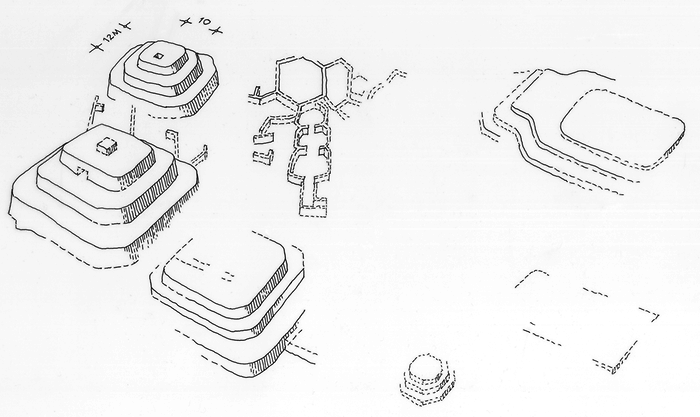Early Step Pyramids in Peru, 4000 m above Sea Level#
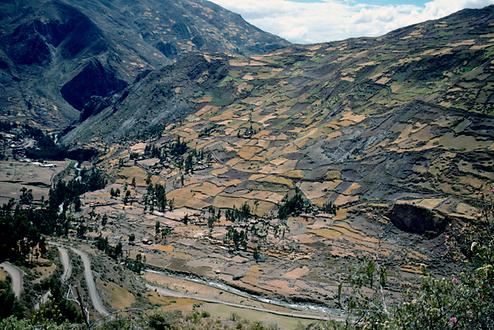
Photo: Hasso Hohmann 1996, under CC BY-SA 4.0
Before I went on a five-week trip to Peru in 2003, Wilhelm Diessl, a colleague from Linz in Graz, called me and said that he had discovered two early pyramids on a small plateau in aerial photographs of the Peruvian military. They are located on the east side of the Huascarán massif in Peru at the Cerro San Rámon at about 3800 m above sea level. He had already named the find after the deep canyon Quebrada Taulliragra. He also called the ruins 'Taulliragra'. When I told him that I was planning to revisit Chavin de Huantar, he asked me to go to see the ruins he had discovered, if possible. A few days later, he sent me some copies of his photographs, which I took with me on the trip.
Around noon on August 1, 2003, I left Huaraz, a city in the Peruvian Andes at 3051 m above sea level, to get to Chavin de Huantar by bus. At this time, the gravel road was in the process of beeing upgraded and broadened. Hence there were long waits and the bus needed - instead of the otherwise four hours - now six and a half hours for the route. Apparently, also the tunnel below the pass across the Cordillera Blanca at about 4500 m above sea level, only roughly cut from the rock and unlit, was to be coated and provided with lights. Due to all this I needed much longer than on my two previous trips to get to Chavin de Huantar and did not arrive until about 7.30 pm. First of all I moved into a small hotel there, where I spent the night and also left a large part of my luggage for the search of Taulliragra the following morning.
Chavin is located in the valley of the River Mosna at about 3200 m above sea level. I had already visited the place in 1970 and 1996. The whole culture was named after this archaeological site. Later on, much older archaeological sites were found in other places, which also have to be attributed to the Chavin culture.
On the morning of of August 2 I started my hike to the ruins of Chavin with relatively light luggage. In the nearby archaeological zone of Chavin a number of things had been excavated since my last visit. Among other things, more tunnels were discovered in the extensive platforms of the complex. I wanted to visit them, if possible. But above all, I had the intention to take a full panoramic picture of the Lanzón with my 15 mm distortion-free wide-angle lens. The Lanzón is a more than 4 m high stone stele in the center of the tunnel labyrinth in the probably oldest of the platforms of the complex from around 1000 BC. The archaeologist Alejandro, a friend of Willi Diessl, showed me some of the new finds and I got to know the new museum. The photo of the Lanzón monolith was my final encounter with it. I had already seen the Lanzón in 1970 for the first time.

Drawing: Wilhelm Diessl 1992, under CC BY-SA 4.0
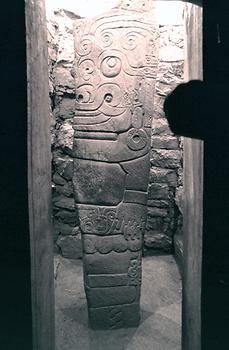
Photo: Hasso Hohmann 2003, under CC BY-SA 4.0
The monolith shows a very elaborate bas-relief with the depiction of a monster with fangs, hair in the form of snakes, with ear jewelry and sharp-clawed paws. From one side I could take a picture of the stele without flashlight and with very little artificial lighting. This is a real challenge in those narrow aisles with its ancones.
In the early afternoon I started for San Marcos in a fully occupied minibus. After a longer wait, I continued the journey on the back of a pick-up truck, downstream at quite low temperature on the provincial road 17A in the Mosna Valley, until the turnoff to a narrow footpath to Huantar (discussed in deail by many bus passengers) came into sight on the left side of the steep slope. A woman living in Huantar also got off the truck and took me in tow. But she was walking so fast on the steep uphill path, that I was only for a short time able to keep up with her. I had already reduced my luggage, but the road ascends steeply almost immediately from my starting point at 2750 m above sea level to Huantar at about 3350 m above sea level.
Although I had walked slower than the local woman, I arrived at Huantar soaked with sweat. In a larger grocery store which was at a pleasant temperature I bought provisions for the planned tour on the following day, emptied several bottles of drinking water and had them show me the footpath to Anyanga, the place I had hoped to reach before darkness and from where I wanted to climb the eastern lower ranges of the mighty Huascarán massif to find the ruins discovered by Willi Diessl on the aerial photo, to check them personally and to take pictures of them.
After Huantar the path went downhill again. It had many turnoffs and there were hardly any people around I could have asked the way. But when it got dark, I nevertheless reached some houses of a scattered settlement - Anyanga. Most of its dwellers hardly spoke any Spanish or no Spanish at all and a certain percentage of them seemed to be kind of demented. I asked a snot-nosed boy whether this was Anyanga, but as an answer he only looked at me with big wide eyes and mouth agape. And the like happened to me with some other children and also with an adult. The people were dressed poorly, their hair probably had not seen water for a long time and their clothes largely made an unwashed and unkempt impression. Perhaps due to the geographic location in such a remote valley inbreeding or other phenomena have led to this?
Two rather intelligent and neat looking children gave me a reasonable answer and led me to their parents' home. It was a rural farmstead separated by a wall from the public path and consisting basically of a large house with outside stairs and a few smaller farm buildings. Here, pigs, a goat, chickens and guinea pigs were kept. There was also a dog for guard. The entire village had no electricity. Therefore, a candle had to provide light. Soon, the friendly parents of the children also arrived. The mother was the medical orderly of Anyanga, alloted medications and administered injections. Here I could sleep on the floor for the next two nights for little money, which I paid immediately. From the mother I learned that the settlement had 120 inhabitants, a small general store and a small school.
The next morning I got up at 5.30 am with the help of my alarm, ate two tuna sandwiches from the previous evening, packed my things for the day and, just to be on the safe side, a bivouac sack into my backpack, shaved outdoors at the watering place at very low temperature, brushed my teeth and, again just to be on the safe side, filled my five empty plastic half litre bottles with water from the farm. The evening before I had observed that the ditch passing through the farm crossed a hog wallow upstream. I assumed that the pigs were still asleep and the water quite clean at this time of the day. Furthermore, I put a Micropur tablet into each bottle for disinfection, a remedy also used by the Austrian military. Then I set off by the light of my torch across a very narrow bridge consisting of three tree trunks lying over a somewhat broader, slightly meandering brook. This brook flowed here at an altitude of 2980 m. Then I turned off to the right and followed a broader gravel track for a while. After a few hundred meters I finally got up to the left to the mountain opposite Anyanga. The previous evening I had already tried in the twilight to align the aerial pictures with reality, and to define my position in the copies. So I had soem idea of directiosn and knew what I had to watch out for here in the valley.
At the beginning the path was still well-trodden, did not ascend too steeply, and passed terraced fields to the right and to the left. Here there were still trees and bushes. Where the steep fields were not cultivated, tall grass grew. In the meantime it got light. Apparently, farming is done mostly on artificial field terraces. Further up, there was an obviously very old terrace wall to the left, which had probably also served as a parapet wall. Parts of it still towered above the terrace level. On the receding area, the remains of a probably pre-Columbian building lay centered(GPS:S9°25.443/W77°11.856/H3210M) -9.5397222, -77.42111111111112 . Later in the morning I came by a longer, relatively elaborate staircase, at the upper end of which a rectangular walled area followed (GPS:S9°25.166/W77°12.564/H3780M) -9.4627778, -77.35666666666667 . Then the path became narrower and finally ended near to a very small and low hut, consisting of an outer stone wall and a tenuous wooden and grass-covered roof structure.

Photo: Hasso Hohmann 2003, under CC BY-SA 4.0
From there I went on in rough terrain. Further up was an expanse of ruins. It seemed to consist of the remains of some older buildings (GPS:S9°24.584/W77°13.117) -9.5622222, -77.24916666666667 . Also on this stretch of the path I was sure where I was in relation to my copies of aerial pictures.
The slopes were steepening which one could not see in the photos. The valley of the Taulliragra river to the right became deeper and deeper and the edges rougher. The prominent rock formations to the north on the other side of the valley clearly showed a narrow path. Yet I did not meet any human being that day, not even in the distance. Only in the evening just before Anyanga did I meet a hunter.
In order to orient myself, I repeatedly tried to identify on the pictures prominent objects from the other side of the valley, which were lying in a row and therefore had to be located in the same vertical plane and to combine them. Two such pairs of objects make two lines in the aerial picture, in the intersection of which I then stand. With the military aerial images available to me this method was not very accurate, but a rough guide.
In spots, the rough terrain was muddy and difficult to pass because of water emerging from the mountain and ravines. Here it showed that all the sources I had already seen from a distance the previous evening on the slopes of the mountain massif have only water with a foul smell of hydrogen sulphide that was not drinkable. Therefore I was glad to have bottled some water in Anyanga despite the hog wallow. In other places I walked over increasingly steeper slopes. At an extremely steep stretch of the path, my backpack brought me into such an imbalance that I was hardly able to prevent a fall. At the end of my hike I walked across a wide basin full of coarse gravel with huge boulders. After lunch I finally reached my destination lying on a hill - the ruins of Taulliragra that Willi Dießl had discovered on the air pictures(S9°24.312 / W77°13.860 / Höhe: 3810M) -9.4866667, -77.45555555555556 .
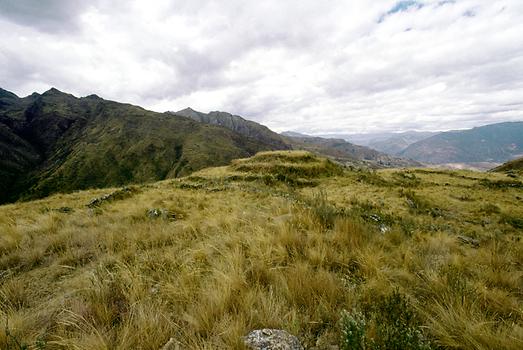
Photo: Hasso Hohmann 2003, under CC BY-SA 4.0
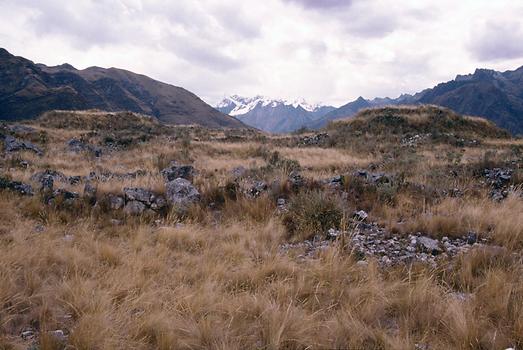
Photo: Hasso Hohmann 2003, under CC BY-SA 4.0
On the spot I drew a sketch of the two not very high pyramids, noticed that the walls of the individual steps are actually rounded off at the corners respectively angled at 45 ° - usually a sign for quite early buildings such as the buildings of La Galgada, which were built around 3000 BC. I made some rough measurements with the measuring tape and added a series of photos.
It turned out that the sketch of the ruins Willi Dießl had made is basically correct around the pyramids. However, some of the other terraces do not exist in this form. These are often detached walls in a basin south of the two pyramids. Maybe they were built in more recent times, since they have not fallen yet. The barely recognizable remnant of a wall apparently even runs across parts of the western pyramid, extends to the eastern one and looks secondarily fitted. Here, beside this wall as well as near the hexagonal, walled field in the area southeast of the eastern pyramid, Diessl had staggered small terraces in several steps downwards.
In reality, and especially in the west of the hexagonal area, these are wall systems with openings. The enclosed fields are now partly overgrown with thorny shrubbery and tall grass. Perhaps once the walls served as a windbreak for small fields, perhaps with crops in between to shield the fields against the icy down draught from the Sierra Blanca?
After a stay of about an hour along with a pause and a short refreshment I went back towards Anyanga. I wanted to avoid darkness. For an in-depth investigation and a detailed mapping of the archaeological zone with its extension of about 130 m (east-west) and 150 m (north-south), one would have had to organize at least one overnight stay on the sport with a tent and thick blankets. At first I walked back the same route and later on a different one to Anyanga, where I just arrived at nightfall.
I spent another night in the farmhouse after I had bought 1.5 liters of Coca Cola and biscuits in the nearby little Tienda. The sun had long since set when I went to bed already at 7 pm. Unfortunately, there were small roommates in my luxuriant bedding - Pulgas, fleas. Unfortunately, it was absolutely impossible to catch and squash them without proper light. On August 4 I got up again in the morning at 5.30 am with the help of my alarm, ate a few biscuits, got ready to go and at 6.00 clock I was back on the road again. This time I did not walk via Huantar again, but crossed the narrow bridge across the brook in the west of Anyanga like the day before, took the gravel road in the west of the brook northwards to the broader gravel road which runs eastwards in the north parallel to the Quebrada Taulliragra.
This route was longer but far less strenuous, because it was sloping only little. The narrow bridge across the Taulliragra river in the north consisted again of only three trunks lying next to each other. But this time, however, some branches and shrubbery were carefully laid close together across it. On top of them lay a thick, relatively firm layer of stones and soil. From afar I could see how a rider crossed the narrow bridge at this early hour to get to the road running west-east to the north. I also took this bridge and arrived after some more walking already at 8.30 am at the T-junction of this gravel road into the main road 14A, respectively at the point where the Taulliragra river I had walked along flows into the Mosna river.
The provincial main road 14A connects Huari in the north with Chavin de Huantar in the south and runs upstream along the River Mosna.
I had to wait an endless hour and a half at this junction until the first vehicle driving in the right direction came along and stopped at my hand signal. In the car were two adults and a child. For 6 Soles they took me to San Marcos. There I immediately had a minibus which took me to Chavin de Huantar and dropped me off at the hotel.
I picked up my large items of luggage and repacked my backpack. But because of the roadworks the bus, however, did not leave until 4.30 pm. Yet a few kilometers further it had to stop again and wait until 18.30 to continue its journey. Therefore, I arrived only late at night in Huaraz, where I stayed again in the small hotel Dido's.
Unfortunately, I could not take any pictures of the valley, the houses and the tunnel on this second part of the return journey from Chavin to Huaraz due to the big delays. However, a series of vertical rock layers of the cliffs beside the road with coal seams in between were interesting. There were tunnels at street level which led into the mountain. Twice I was able to look into the dimly lit coal mines, where indigenous workers from the Mosna Valley mined their fuel. They obviously also worked at night.
Much later, back in Austria, I spoke with Willi Diessl about Taulliragra and showed him my sketches and photos. However, as my results seemed to be insufficient for him, or because he did not want to trust them, he decided to travel to Taulliragra the following year for himself. In Anyanga he took a guide who claimed to know the ruins. But obviously, he did not know the pyramids of Taulliragra and neither could find or reach the two pyramids, not even with the help of the aerial photographs.
Back in in Linz, Wilhelm Diessl was still angry with his guide. But only on the basis of my informations he did not want to change his drawing for his book entitled 'Huantar San Marcos. Sitios Arqueologicos de la Sierra de Ancash', which was published in 2005 in Lima, Peru after endless quarrels with the local printing press, without having seen the ruins himself. So his drawing remain an interesting document based on aerial photos - unfortunately with some errors. Willi Diessl died much too early in 2007 without having the occasion to travel to Peru again.

Drawing: Wilhelm Dießl 2002, under CC BY-SA 4.0
